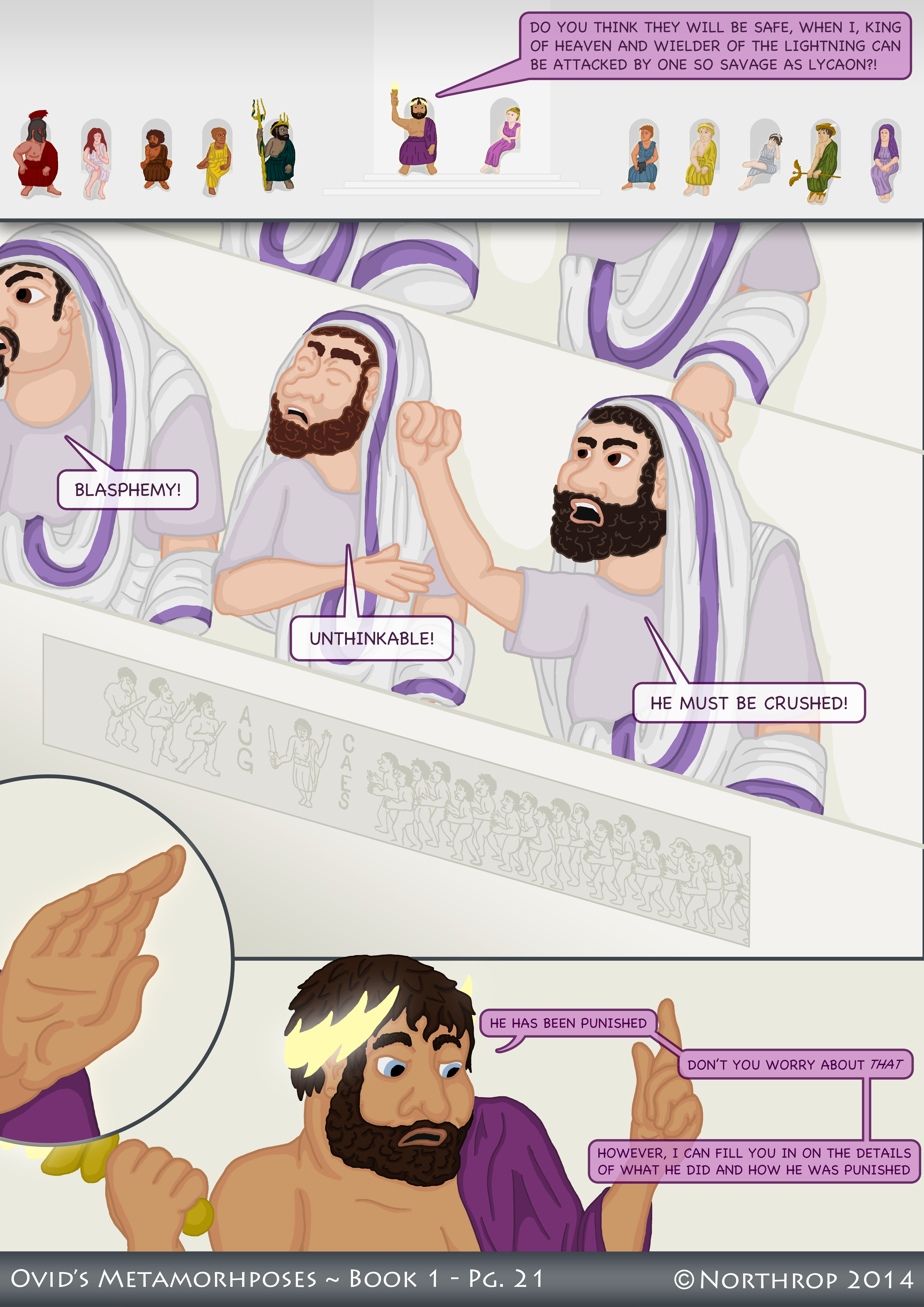Met. 1.197-210 – Jupiter’s Speech [Part 2]
“CUM MIHI, QUI FULMEN, QUI VOS HABEOQUE REGOQUE,
STRUXERIT INSIDIAS NOTUS FERITATE LYCAON?”
CONFREMURE OMNES STUDIISQUE ARDENTIBUS AUSUM
TALIA DEPOSCUNT. SIC, CUM MANUS IMPIA SAEVIT
SANGUINE CAESAREO ROMANUM EXSTINGUERE NOMEN,
ATTONITUM TANTO SUBITAE TERRORE RUINAE
HUMANUM GENUS EST TOTUSQUE PERHORRUIT ORBIS.
NEC TIBI GRATA MINUS PIETAS, AUGUSTE, TUORUM EST
QUAM FUIT ILLA IOVI. QUI POSTQUAM VOCE MANUQUE
MURMURA COMPRESSIT, TENUERE SILENTIA RUPIT:
“ILLE QUIDEM POENAS (CURAM HANC DEMITTITE) SOLUIT;
QUOD TAMEN ADMISSUM, QUAE SIT VINDICTA DOCEBO.”
“WHEN I, WHO HAVE AND DIRECT THE LIGHTNING BOLT, AND HAVE AND DIRECT YOU ALL,
CAN BE THE VICTIM OF THE TREACHERIES DEVISED BY A MAN NOTED FOR HIS SAVAGERY, LYCAON?”
THEY WERE ALL IN AN UPROAR, AND DEMANDED THE ONE WHO HAD DARED SUCH THINGS WITH ARDENT ZEAL. AS, WHEN THE IMPIOUS BAND RAGED
TO EXTINGUISH THE NAME OF ROMANS WITH CAESAR’S BLOOD,
THE HUMAN RACE WAS STRUCK WITH THE TERROR OF SUDDEN RUIN
AND WHOLE WORLD SHOOK THROUGHOUT.
NOR WAS THEIR PIETY LESS WELCOME TO YOU, AUGUSTUS,
THAN THAT WAS TO JUPITER. AFTERWARD, HE SETTLED THE MURMURING
WITH HIS VOICE AND HAND, AND BROKE THE SILENCE THEY WERE KEEPING:
“HE HAS BEEN PUNISHED (LAY ASIDE THIS CARE);
NEVERTHELESS, I WILL TELL YOU WHAT HAPPENED AND WHAT WAS HIS PUNISHMENT.”
Sorry for the late update, y’all. It’s been hectic here recently between teaching, researching and other stuff. I didn’t have today’s page finished until just now! It’s still technically Monday here in the UK…
I have to sleep soon, so my post will be short. I just wanted to talk about a couple things that I found interesting about this page. First of all, this is the first time we get to see the whole Pantheon! [Bonus points to anyone who can name them all in the comments…] I decided to do a wide shot, so that I could practice my character design; the small size means I have to make them distinct in their forms, not just details (the silhouette test* requires characters to be recognisable by their outlines alone). I wanted to go for something between standard, cultic depictions and stylised cartoonishness. How do you think I did?
Of course, this page continues my controversial depiction of the council of the gods, showing ‘minor’ heaven-dwelling gods in the council alongside the Olympians. Certainly the Olympians are accorded a place of special honour in my depiction (even if some of them aren’t paying attention**). However, the polemic is there. I’d be curious to hear what you all think about it? Did I do well, or am I going to burn in classicist hell forever?
The other thing I wanted to point out is that this passage is our first example of an epic simile!*** Now, these were always going to be hard to depict in comic form. Similes primarily exist (at least in terms of their narrative function) to illustrate poetry, which is a non-visual medium. Obviously, I am working in comics, an execessively visual medium. To compound the issue, the simile in question here is a highly referential one, which serves an important political purpose. It compares Jupiter to the Emperor Augustus, injecting a whole new level of political complications into this episode. We have already seen how Ovid refers to the palace of Jupiter as the Palatine of Heaven, and implies that the higher gods are akin to patrician Romans. Now, this simile makes the political subtext in this scene ever more explicit. How have I incorportated it? Well, there is the bas-relief on the wall under the gods in the centre panel; that depicts essentially what the simile depicts. I think this will be my most common way of incorportating similes. They are, in some sense, poetic window-dressing, and thus can be transformed into meta-art within the comic. However, I have taken the simile on board in a much more profound way. It has informed my own political depictions throughout the last few pages, and just as it colours our reading of the poem, I try to make it colour my artwork. I think this is the truest use of simile in poetry, and makes a fine way to translate it to the medium of comics.
That is all for now. I need to sleep and go supervise some students tomorrow (who are actually working on this very scene!). So, until next week, macte esto!
* Link to Aaron Diaz’s (AKA Dresden Codak) explanation of figures in comic theory.
** ~cough~ Venus ~cough~
*** Those of you wondering what a simile is should read the translation under the comic – it’s the part there Ovid makes the comparison with the assassination attempt on Augustus†
† Meta-footnote: Yes, I know the translation is controversial and the Latin may either refer to the assassination of Julius Caesar or an attempted assassination on Augustus. I went with the assassination attempt because it was actually simpler to incorporate into the comic.

Discussion ¬